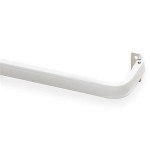How To Keep Shower Curtain From Getting Moldy
Shower curtains, a seemingly innocuous element of the bathroom, are highly susceptible to mold and mildew growth. The warm, humid environment within a shower stall provides ideal conditions for these microorganisms to thrive. Mold and mildew not only present an unsightly appearance but can also pose health risks, particularly for individuals with allergies or respiratory sensitivities. Preventing mold growth on a shower curtain requires a proactive and consistent approach, incorporating strategies to minimize moisture retention and inhibit microbial proliferation.
The primary factors contributing to shower curtain mold are moisture, warmth, and organic matter. Water droplets linger on the curtain surface after each shower, providing the necessary moisture. The enclosed space of the shower stall retains warmth, accelerating the growth process. Soap scum, body oils, and dead skin cells accumulate on the curtain, serving as a food source for mold and mildew. Addressing each of these factors is crucial for effectively preventing mold and maintaining a clean and healthy bathroom environment.
Ensure Adequate Ventilation
Proper ventilation is arguably the most vital step in preventing shower curtain mold. It facilitates the evaporation of moisture, thereby reducing the favorable conditions for microbial growth. Bathrooms often lack adequate natural ventilation, relying instead on exhaust fans. The effectiveness of these fans can vary significantly, and many individuals fail to use them consistently after showering. Therefore, optimizing ventilation is paramount.
The most basic measure is to run the exhaust fan for at least 20-30 minutes after each shower. This duration allows sufficient time for the humidity level in the bathroom to decrease significantly. If the bathroom lacks an exhaust fan or the existing fan is inadequate, consider upgrading to a more powerful model. The fan's capacity should be appropriate for the size of the bathroom, measured in cubic feet per minute (CFM). A general rule of thumb is to have 1 CFM per square foot of bathroom area. For bathrooms with ceilings higher than eight feet, additional CFM may be necessary.
In addition to exhaust fans, opening windows during and after showering, if feasible, can significantly improve ventilation. The influx of fresh air helps to disperse moisture and lower humidity levels. However, this approach may not be practical in all climates or situations. If opening a window is not possible, consider leaving the bathroom door ajar after showering to allow for air circulation from other parts of the house. This practice can help to prevent moisture buildup within the confined space.
Another often-overlooked aspect of ventilation is ensuring that the air vents are clean and unobstructed. Dust and debris can accumulate in vents, reducing their efficiency and hindering airflow. Regularly cleaning the vents with a vacuum cleaner or brush can help to maintain optimal ventilation performance. Furthermore, any obstructions near the shower curtain, such as bath mats or storage containers, should be repositioned to allow for better air circulation around the curtain.
Regular Cleaning and Maintenance
Consistent cleaning is essential for removing soap scum, body oils, and other organic matter that serve as a food source for mold. The frequency of cleaning depends on the usage of the shower and the overall humidity levels in the bathroom. Generally, cleaning the shower curtain every one to two weeks is recommended for optimal mold prevention. Ignoring this routine allows the build-up of residue and microbial colonies to flourish.
Several cleaning methods can be employed. For machine-washable curtains, laundering them in a washing machine with warm water and detergent is an effective approach. Adding a cup of white vinegar or baking soda to the wash can further enhance cleaning power and deodorize the curtain. Avoid using harsh chemicals or bleach, as these can damage the curtain material and potentially release harmful fumes. After washing, hang the curtain to dry completely, preferably in a well-ventilated area. Tumble drying is generally not recommended, as it can cause the curtain to shrink or warp.
For non-machine-washable curtains, hand washing with a mild soap and water solution is necessary. Use a sponge or soft brush to gently scrub the curtain surface, paying particular attention to areas with visible mold or mildew. Rinse thoroughly with clean water and allow the curtain to air dry completely. A spray bottle filled with a diluted vinegar solution (equal parts white vinegar and water) can also be used as a cleaning agent. Spray the solution onto the curtain, let it sit for a few minutes, and then wipe clean with a damp cloth.
In addition to regular cleaning, consider wiping down the shower curtain with a dry towel after each shower. This simple practice helps to remove excess water and prevent moisture buildup. Regularly inspecting the curtain for signs of mold or mildew is also important. Early detection allows for prompt cleaning and prevents the problem from escalating.
Choose the Right Materials
The material of the shower curtain significantly impacts its susceptibility to mold growth. Certain materials are more resistant to moisture absorption and microbial proliferation than others. Selecting materials with inherent antimicrobial properties can further reduce the risk of mold.
Vinyl shower curtains are a common and relatively inexpensive option. However, vinyl is not inherently mold-resistant and can become brittle over time. Fabric shower curtains, typically made of polyester or nylon, are generally more durable and aesthetically pleasing. However, they can also absorb more moisture than vinyl curtains, making them more prone to mold growth. When choosing a fabric shower curtain, opt for one that is treated with a water-repellent or antimicrobial finish. These finishes help to prevent water absorption and inhibit the growth of mold and mildew.
PEVA (polyethylene vinyl acetate) is another alternative to traditional vinyl. PEVA is considered to be a more environmentally friendly option, as it does not contain chlorine. It is also generally more flexible and durable than vinyl. However, like vinyl, PEVA is not inherently mold-resistant and may require regular cleaning to prevent mold growth.
Consider using a shower curtain liner in conjunction with a decorative shower curtain. Liners are typically made of waterproof materials, such as vinyl or PEVA, and serve as a barrier between the decorative curtain and the water. This can help to protect the decorative curtain from moisture and reduce the risk of mold growth. Shower curtain liners are also relatively inexpensive and easy to replace, making them a practical option for mold prevention. Replace the liner more often than the outer curtain. Using two curtains, one inside the stall and one outside, allows the outer decorative curtain to remain dry and mold free. The inner curtain can be replaced more often or cleaned by methods described above.
Regardless of the material chosen, maintaining good ventilation and cleaning habits remains crucial for preventing shower curtain mold. No material is completely immune to mold growth, so proactive measures are always necessary.
In conclusion, preventing shower curtain mold is an ongoing process that requires attention to detail and consistent effort. By prioritizing ventilation, cleaning regularly, and selecting appropriate materials, one can effectively minimize the risk of mold growth and maintain a clean and healthy bathroom environment. Neglecting these preventative measures can lead to unsightly mold, potential health risks, and the premature replacement of the shower curtain.

How To Prevent Mold On A Shower Curtain Easy Cleaning Tips

How To Easily Prevent Mold On A Shower Curtain

How To Prevent Mould Growth On Your Shower Curtain And Keep It As Dry Possible Express Co Uk

How To Prevent Mold On A Shower Curtain Easy Cleaning Tips

How To Prevent Mold On A Shower Curtain Easy Cleaning Tips

How To Prevent Mold On A Shower Curtain Easy Cleaning Tips

How To Prevent Mold On A Shower Curtain Easy Cleaning Tips

How To Easily Clean Your Shower Curtain Liner Molly Maid

How To Prevent Mold On A Shower Curtain Easy Cleaning Tips

How To Prevent Mold On A Shower Curtain Easy Cleaning Tips








